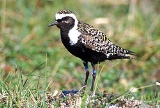
Pluvialis
Encyclopedia
Pluvialis is a genus of plover
s, a group of wading
bird
s. There are four species which breed in the temperate or Arctic
Northern Hemisphere
.
In breeding plumage, they all have largely black underparts, and golden or silvery upperparts. They have relatively short bills and feed mainly on insects, worms or other invertebrates, depending on habitat, which are obtained by a run-and-pause technique, rather than the steady probing of some other wader groups. They hunt by sight, rather than by feel as do longer-billed waders.
The American and Pacific Golden Plovers were formerly considered conspecific (as "Lesser Golden Plover"; Sangster et al., 2002)
Plover
Plovers are a widely distributed group of wading birds belonging to the subfamily Charadriinae. There are about 40 species in the subfamily, most of them called "plover" or "dotterel". The closely related lapwing subfamily, Vanellinae, comprises another 20-odd species.Plovers are found throughout...
s, a group of wading
Wader
Waders, called shorebirds in North America , are members of the order Charadriiformes, excluding the more marine web-footed seabird groups. The latter are the skuas , gulls , terns , skimmers , and auks...
bird
Bird
Birds are feathered, winged, bipedal, endothermic , egg-laying, vertebrate animals. Around 10,000 living species and 188 families makes them the most speciose class of tetrapod vertebrates. They inhabit ecosystems across the globe, from the Arctic to the Antarctic. Extant birds range in size from...
s. There are four species which breed in the temperate or Arctic
Arctic
The Arctic is a region located at the northern-most part of the Earth. The Arctic consists of the Arctic Ocean and parts of Canada, Russia, Greenland, the United States, Norway, Sweden, Finland, and Iceland. The Arctic region consists of a vast, ice-covered ocean, surrounded by treeless permafrost...
Northern Hemisphere
Northern Hemisphere
The Northern Hemisphere is the half of a planet that is north of its equator—the word hemisphere literally means “half sphere”. It is also that half of the celestial sphere north of the celestial equator...
.
In breeding plumage, they all have largely black underparts, and golden or silvery upperparts. They have relatively short bills and feed mainly on insects, worms or other invertebrates, depending on habitat, which are obtained by a run-and-pause technique, rather than the steady probing of some other wader groups. They hunt by sight, rather than by feel as do longer-billed waders.
Species in taxonomic order
- European Golden Plover, Pluvialis apricaria
- Pacific Golden PloverPacific Golden PloverThe Pacific Golden Plover is a medium-sized plover.The 23–26 cm long breeding adult is spotted gold and black on the crown, back and wings. Its face and neck are black with a white border and it has a black breast and a dark rump. The legs are black...
, Pluvialis fulva - American Golden PloverAmerican Golden PloverThe American Golden Plover is a medium-sized plover.Adults are spotted gold and black on the crown, back and wings. Their face and neck are black with a white border; they have a black breast and a dark rump. The legs are black....
, Pluvialis dominica - Grey PloverGrey PloverThe Grey Plover , known as the Black-bellied Plover in North America, is a medium-sized plover breeding in arctic regions. It is a long-distance migrant, with a nearly worldwide coastal distribution when not breeding....
or Black-bellied Plover, Pluvialis squatarola
The American and Pacific Golden Plovers were formerly considered conspecific (as "Lesser Golden Plover"; Sangster et al., 2002)

